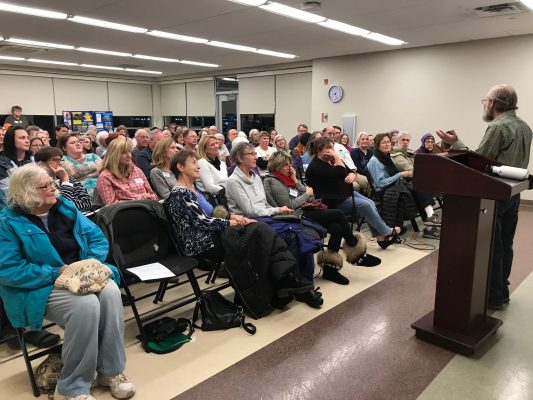Wednesday, January 9, 2019
 Our January Gathering featured the presentation “What’s in a Name?”, by guest speaker, Dr. James Trager, Restoration Biologist at the Missouri Botanical Garden (SNR) with an introduction from chapter board member Dawn Weber. 62 members and 33 guests attended the gathering at our new indoor location home, the Brentwood Community Center.
Our January Gathering featured the presentation “What’s in a Name?”, by guest speaker, Dr. James Trager, Restoration Biologist at the Missouri Botanical Garden (SNR) with an introduction from chapter board member Dawn Weber. 62 members and 33 guests attended the gathering at our new indoor location home, the Brentwood Community Center.
After the welcome from our president, Marsha Gebhardt, she recognized our board members and our program committee for all their hard work in creative a wonderful program for the coming year.
Dawn began the program by sharing the feelings of most attendees when the subject of Latin (with some Greek and other variances) botanical names is discussed. Learning them is certainly challenging, but running away, hiding, sleeping in class or acting like a know-it-all will not get us very far in the world of learning scientific plant names!
Dr. Trager began by discussing the rules of the system of binomial nomenclature (two terms) that was started by Carl Linnaeus in the 1753, when he published his first book, Systema Naturae. He was the Swedish botanist who created the system as is stands today. The International Code of Nomenclature (ICN) is the over-arching body that governs the system today.
Many ask why such a system is needed and it is explained that each language is not universal. Having a standard name for each plant makes it easier for botanists or gardeners to communicate with each other. For example, Quercus alba is a white oak all over the world.
Dr. Trager went on explain the different terms or labels that you may see on plants.
Here are a few examples:
- Genus is the first name and is capitalized and italicized
- Species is the second name and describes characteristics unique to a plant and is not capitalized, but italicized
- ‘sp’ is used when the actual name cannot or need not be specified
- ‘spp’ indicates several species
- ‘L’ is the standard abbreviation for “Linnaeus”; the absence of parentheses shows that this is the original name
- n.s. indicates a new species
- Cultivars refers to selecting/breeding plants for desirable characteristics
- Nativar indicates a variety selected from a native species for it’s horticultural qualities, like more colors
- ‘X’ indicates a hybrid
Then Dr. Trager went on to the really hard part—pronunciation of these Latin terms! His advice is to pronounce every syllable slowly including silent ‘E’s”.
Did you know that the MOBOT Plant Finder has recordings of the plant name pronunciations? If you search for the name of the plant and click to see the details, you’ll see a speaker icon next to to the plant name. Click to hear a pronunciation of the name, and play as many times as you like.
One member’s question of where they could go to learn Latin was answered by “Go to Catholic school”, followed by a roomful of laughter!
Master Gardeners attending the program are eligible for 1 CEU.
Happily recorded by
Ginny Johnson, Secretary

